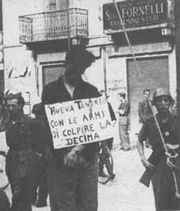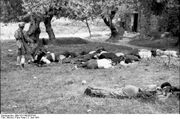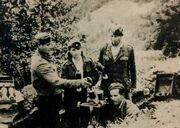Previous: F. Claudin, Part 1
Ch.5: Revolution and spheres of influence
France 1939-1944

Leaders of the "Free French" in front of Roosevelt and Churchill
We have already seen that the Communists from adopting an extreme left position (critique of Social Democracy) went over to an extreme right position of alliance with bourgeois "progressive" parties, in some cases even dissolving the Communist party into a bourgeois party (China). As a result of USSR’s alliance with France in preparation for WWII, “On 1 Sept. 1939 the (French) Communist parliamentary group unanimously proclaimed ‘the unshakeable determination of all Communists to stand in the front line against Hitlerian Fascist aggression’, and on 1 Sept. the Communist deputies voted for war credits”. This was clearly a mistake.

French underground newspaper.
Instead of supporting the communist movement within each capitalist country, the USSR allied itself with the ruling classes of these countries. This forced the communists in these countries to adopt a position similar to Social Democracy prior to the beginning of WWI, i.e. social patriotism. But the USSR could not support the communist movement against the bourgeoisie as it was suppressing revolution at home, fighting those who supported the idea of a "permanent revolution", those who opposed special privileges for the bureaucracy, those who proposed workers management of the enterprises, etc.
“By supporting the Gaullist solution the PCF was preparing the way for the restoration of French capitalism”. The USSR supported de Gaul and suppressed the French partisans, the Resistance.

German poster of spring 1944, stressing Jewish and communist membership of the Resistance

French resistance fighters
“as soon as (the French Communist leader) Thorez arrived (in France from Moscow), the party organizations received internal instructions to disband the militias and surrender their arms”. This was at the end of 1944-early 1945. The left elements in the PCF were called “Hitlero-Trotskyites”. This was exactly the policy favored by De Gaul. Upon arriving in France, he
“began to install his machinery and limit the powers of the liberation committees.” The capitalist state machinery, broken by the Hitler's invasion of France, was restored thanks to the
"Hair punishment" to the French women who collaborated with the Germans
At the end of WWII, the PCF “was associated with all the acts of colonialist repression practiced by successive French governments”. For example, they give support for France to stay in Algiers.
Italy during WWII

An Italian partisan hung by fascists
In Italy, the situation during WWII was similar as in France. In Italy, “the partisan movement grew very fast”. Luigi Longo writes: “there existed in many regions a de facto duality of power, the organs of the Fascist authorities, which were becoming increasingly discredited, and the anti-Fascist executive organs, existing illegally but enjoying great popularity among the people”. This is the situation existing in Afghanistan today. The partisans are the Taliban, the fascist authorities are the U.S., German, etc. military authorities supporting the marionette government of Hamid Karzai. The situation is really that of a duality of power.
The partisans of Northern Italy sign “a Rome protocol”, in which “the partisans undertook to obey British and American instructions on the conduct of the war, to appoint as military leader of the partisan army an allied ‘secret officer’ and follow his instructions”. Thus the Allies gained a guarantee that the partisans “would not make a revolution”.

Partisans in Milan

Mussolini (second from left) and other fascists hung, 1945
is to struggle against the CP’s, SP’s (socialist parties), and pseudo-Trotskyist parties from the left.
Civil war in Yugoslavia, 1941-45

Yugoslav partisan Stjepan Filipovic shouting "Death to fascism, freedom to the people" before hanging
In Yugoslavia, the “national liberation and the revolutionary transformation of the country were closely linked”. This we don’t see today in Iraq. “The war of liberation inevitably took on at the same time the form of a civil war against the bourgeoisie and the big landowners”. This is what must be done in Iraq.

Leaders of the Yugoslav partisans: Rankovic, Tito, Djilas
The CP in Yugoslavia did not make an alliance with Mihailovic and his Chetniks. As a result, the later were isolated, as they were “obliged to reveal before the people their reactionary aims, the preservation of the old exploitative social system which they held out as the reward of the sacrifices and heroism of the resistance fighters”. This implies that, for example in Iraq, the resistance fighters should not compromise with the remnants of the Saddam Hussein regime, the Sunni army officers. Rather, the Shiites together with Sunnis should fight both the remnants of the old regime, who cooperate now more and more with occupation authorities, and the American army.
The examples of France and Italy show that inside the Comintern, the reaction predominated over revolution in 1940’s. Where the Communist leadership was isolated from Comintern, as in the case of Yugoslavia and China, the communists still were a revolutionary force.
Civil war in Greece

Greek civilians killed by German paratroopers, 1941
In Greece, “the leadership of the Greek Communist Party was unable to resist the pressure of Moscow with the firmness of the Yugoslav party. It made serious concessions to the policy of ‘national unity’ and accepted compromises with the allies which facilitated the British army’s intervention against the Greek resistance”. In 1946 a civil war in Greece starts. “Feeling too weak to cope with the situation, British imperialism gave up its role of policeman to American

After street fighting in Athens between communists and British troops, 1944
imperialism, and on 12 March 1947 Truman announced that the U.S. was undertaking the ‘protection’ of Greece and Turkey as the first application of the ‘Truman doctrine’.” Stalin did not lend any support to the revolution in Greece, as a result of his agreement with Churchill, dividing up a priori the spheres of influence in Europe between the USSR and Britain.
Preliminary conclusion: we see that as a result of a world war there is a Resistance movement. A preliminary list would include:
- Albanian resistance movement
- Austrian resistance movement, e.g. O5
- Belgian Resistance
- Bulgarian resistance movement
- Burmese resistance movement (AFPFL – Anti-Fascist People's Freedom League)
- Lithuanian, Latvian and Estonian anti-Soviet resistance movements ("Forest Brothers")
- Czech resistance movement
- Danish resistance movement
- Dutch resistance movement
- French resistance movement
- German anti-Nazi resistance movement
- Werwolf, the German resistance against the Allied occupation
- Greek Resistance
- Chinese resistance movements
- Hong Kong resistance movements
- Italian resistance movement
- Jewish resistance movement
- Korea resistance movement
- Luxembourgs resistance during World War II
- Malayan resistance movemment
- Norwegian resistance movement
- Philippine resistance movement
- Polish resistance movement
- Romanian resistance movement
- Singaporean resistance movement
- Slovak resistance movement
- Soviet resistance movement
- Thai resistance movement
- Ukrainian Insurgent Army (anti-German, anti-Soviet and anti-Polish resistance movement)
- Viet Minh
- Yugoslavia

Communist controlled Democratic Army of Greece (DSE) soldiers training in the use of a mortar
Often, the Resistance movement is split by a civil war. This is a civil war between communists and anti-communists (e.g. in China: the CP of China against the Nationalists, the Kuomintang).
As a rule, the resistance to the occupation forces is led by communists. If the resistance does not cooperate with remnants of the former capitalist regime (e.g. in Yugoslavia these were the Chetniks of Mihailovic), or, what's most important, does not cooperate with Stalinists (e.g. in Spain the Communist Party of Spain, and hence with the Communist Party of the Soviet Union), then the communist-led Resistance has a good chance to turn into a regular army and defeat the national oppressor, while at the same time achieving a socialist revolution. Hence, the policy for the future resistance movements.
In some cases, the civil war within the amorphous resistance movement can take place after victory over the occupation forces. For example, in Greece the civil war started after the end of the German occupation. The Greek communists were defeated because they allied themselves to Stalin. In the course of WWII, Stalin ordered the Greek communists not to interfere in his alliance with Britain. After 1945, the Greek Communist Party supported Stalin in his struggle with Tito, who provided the main material support to the Democratic Army of Greece, DSE.
Next: F. Claudin, Part 3